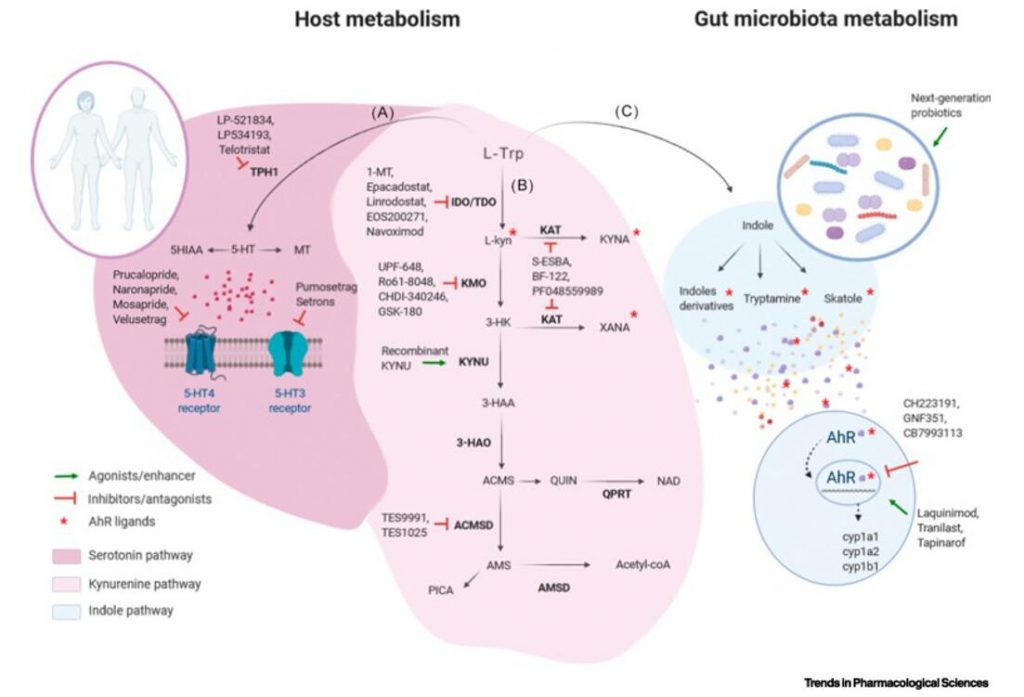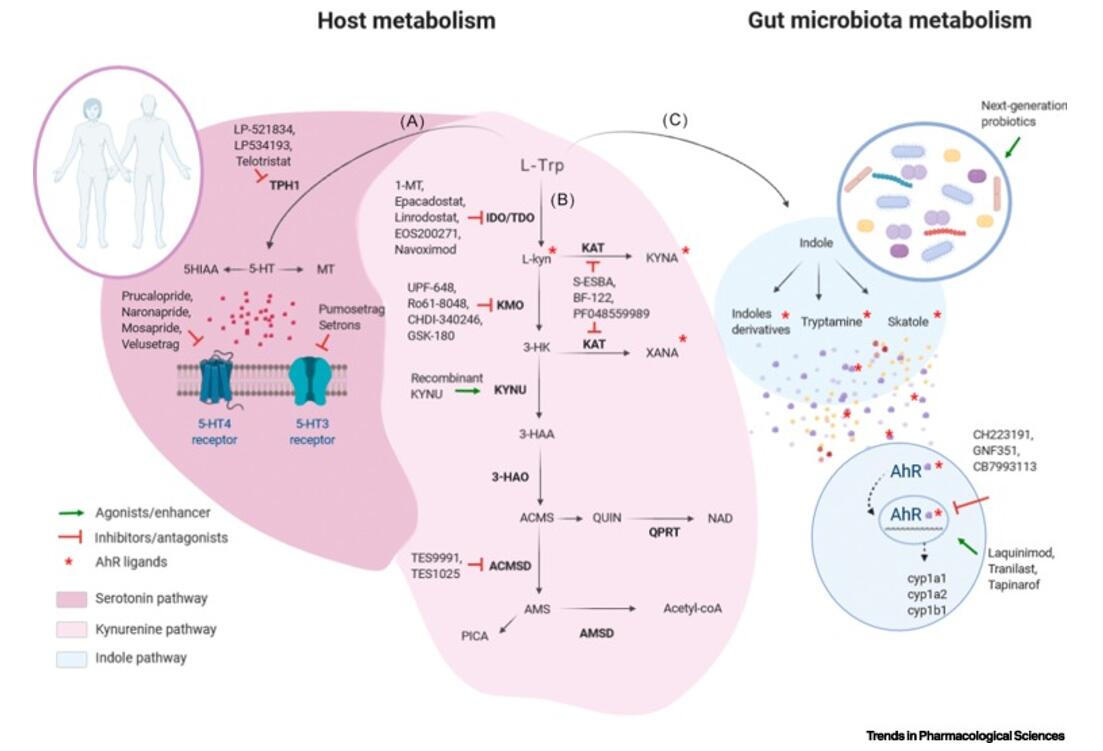Tryptophan, an essential amino acid, plays a critical role in various biological processes. It serves as a building block for protein synthesis and acts as a precursor for the biosynthesis of important molecules such as serotonin, melatonin, and niacin. The metabolism of tryptophan is a complex process involving multiple enzymatic reactions and metabolic pathways. Understanding the intricate details of tryptophan metabolism is essential for unraveling its biological significance and potential applications in health and disease.
Tryptophan Metabolism Pathways
Tryptophan metabolism can be divided into two major pathways: the kynurenine pathway and the serotonin pathway. The kynurenine pathway primarily occurs in the liver and involves the enzymatic degradation of tryptophan into kynurenine, which is further metabolized into various downstream metabolites such as kynurenic acid, quinolinic acid, and picolinic acid. This pathway is primarily regulated by the rate-limiting enzyme, indoleamine 2,3-dioxygenase (IDO), and serves as a key link between tryptophan metabolism and immune responses, neurodegenerative disorders, and other diseases.
On the other hand, the serotonin pathway predominantly occurs in the central nervous system and gastrointestinal tract. It involves the conversion of tryptophan into 5-hydroxytryptophan (5-HTP) by the enzyme tryptophan hydroxylase (TPH), followed by the conversion of 5-HTP into serotonin (5-hydroxytryptamine) by the enzyme aromatic amino acid decarboxylase (AADC). Serotonin is a neurotransmitter that regulates mood, appetite, sleep, and various other physiological processes. Dysregulation of the serotonin pathway has been implicated in psychiatric disorders such as depression, anxiety, and schizophrenia.

L-Trp Metabolism and Pharmacological Targets (Modoux et al., 2021).
Analyzing Tryptophan Metabolism
A thorough knowledge of the levels and dynamics of tryptophan and its metabolites is provided by metabolomic analysis, a potent method for examining tryptophan metabolism. To study and interpret the intricate metabolic profiles of biological materials, metabolomics blends cutting-edge analytical methods with bioinformatics tools. Tryptophan metabolism analysis makes use of a number of methods and tools and provides insightful information about how it is regulated and its potential applications.
Liquid Chromatography-Mass Spectrometry (LC-MS)
LC-MS is a widely used analytical technique in metabolomics studies to quantify small molecules such as tryptophan and its metabolites. It combines the separation capabilities of liquid chromatography with the detection and identification capabilities of mass spectrometry. LC-MS allows for the simultaneous analysis of multiple metabolites in complex biological samples, providing a comprehensive view of tryptophan metabolism and its alterations under different conditions.
Nuclear Magnetic Resonance (NMR) Spectroscopy
Another useful tool for analyzing tryptophan metabolism is NMR spectroscopy. It enables researchers to recognize and measure metabolites involved in tryptophan metabolism by giving information about the chemical structure and makeup of molecules. NMR-based metabolomics provides untargeted investigation of metabolites, offering a comprehensive perspective of metabolic alterations related to tryptophan metabolism.
Stable Isotope Tracing
Stable isotope tracing is a technique used to track the fate of a labeled molecule within a metabolic pathway. In the contextof tryptophan metabolism analysis, stable isotope-labeled tryptophan can be administered to study its conversion into downstream metabolites. By monitoring the incorporation of stable isotopes into specific metabolites, researchers can gain insights into the dynamics of tryptophan metabolism and its regulation.
Enzyme Activity Assays and Gene Expression Analysis
To understand the regulation of tryptophan metabolism, researchers often assess the activity of key enzymes involved in the pathway. Enzyme activity assays measure the rate at which a specific enzyme catalyzes a particular reaction, providing information about its functional state. Additionally, gene expression analysis through techniques like quantitative real-time polymerase chain reaction (qRT-PCR) or RNA sequencing can elucidate the transcriptional regulation of enzymes involved in tryptophan metabolism.
Implications of Tryptophan Metabolism Analysis
Tryptophan metabolism analysis has significant implications in various physiological and pathological conditions. Here are a few notable examples:
Immune Responses and Inflammation
The kynurenine pathway of tryptophan metabolism has been closely linked to immune responses and inflammation. Activation of IDO, the rate-limiting enzyme in this pathway, leads to the depletion of tryptophan and the production of immunomodulatory metabolites such as kynurenine. Dysregulation of this pathway has been associated with autoimmune disorders, chronic inflammation, and immune evasion by certain pathogens. Tryptophan metabolism analysis can provide valuable insights into the interplay between immune responses and tryptophan metabolism, opening new avenues for therapeutic interventions.
Neurodegenerative Disorders
Tryptophan metabolism, particularly the kynurenine pathway, has been implicated in the pathogenesis of neurodegenerative disorders such as Alzheimer's disease, Parkinson's disease, and Huntington's disease. Imbalances in the production of kynurenine metabolites, such as quinolinic acid, have been associated with neurotoxicity and neuronal cell death. By analyzing tryptophan metabolism in the context of neurodegenerative disorders, researchers aim to identify potential biomarkers and therapeutic targets for these debilitating conditions.
Mood Disorders and Mental Health
The serotonin pathway of tryptophan metabolism plays a crucial role in the regulation of mood and mental health. Alterations in serotonin levels have been linked to mood disorders such as depression and anxiety. By examining the activity of enzymes involved in serotonin synthesis and degradation, researchers can gain insights into the underlying mechanisms of these disorders and develop targeted interventions, such as selective serotonin reuptake inhibitors (SSRIs), to modulate serotonin levels.
Reference
Modoux, Morgane, et al. "Tryptophan metabolism as a pharmacological target." Trends in Pharmacological Sciences 42.1 (2021): 60-73.
